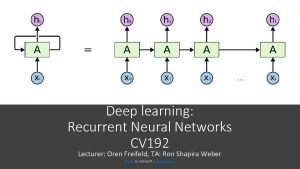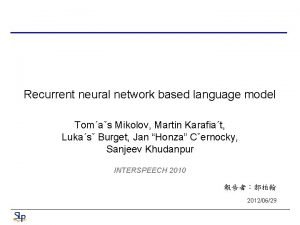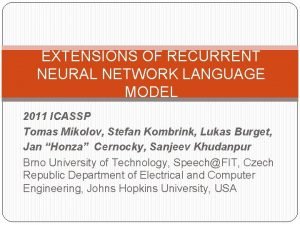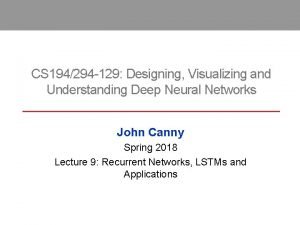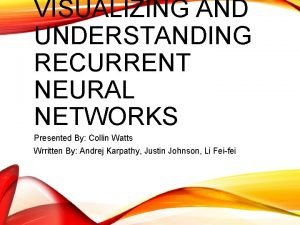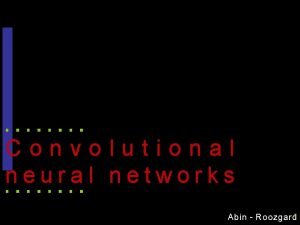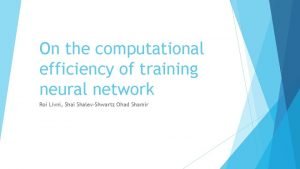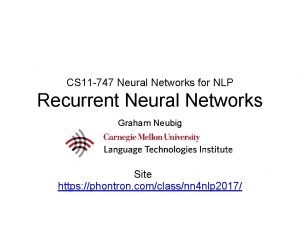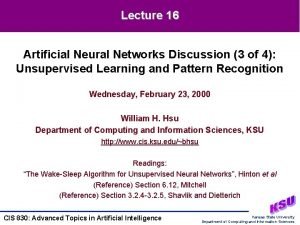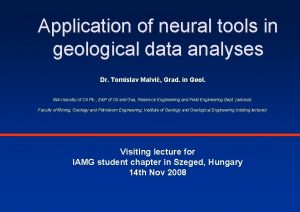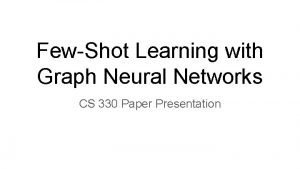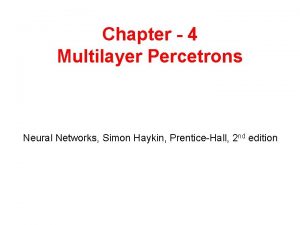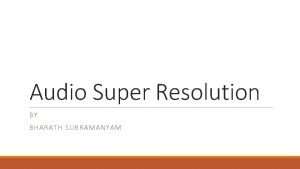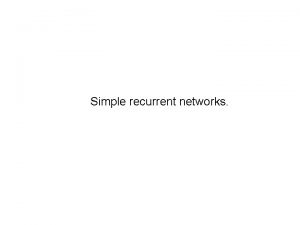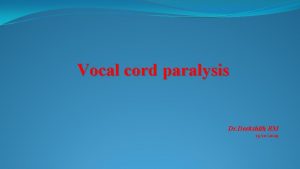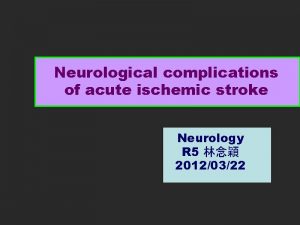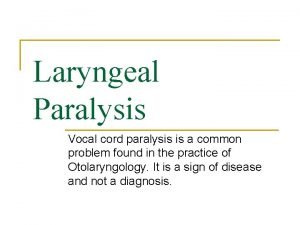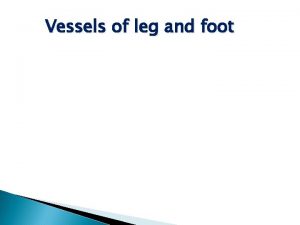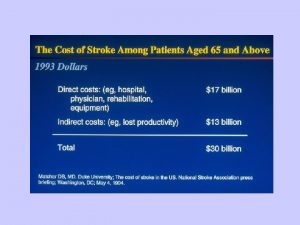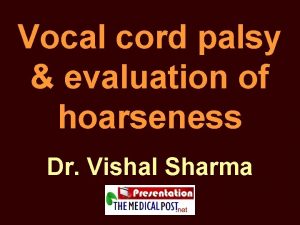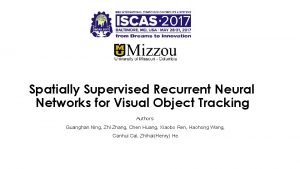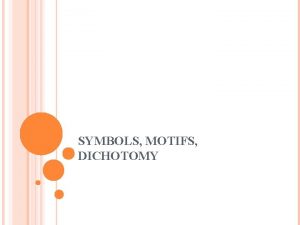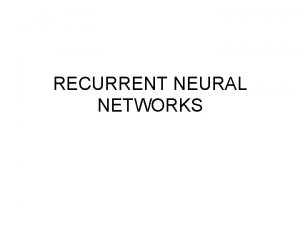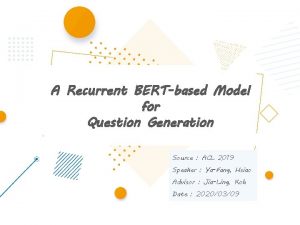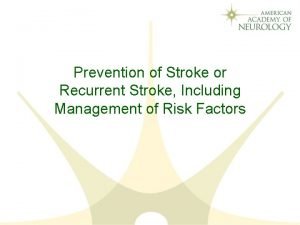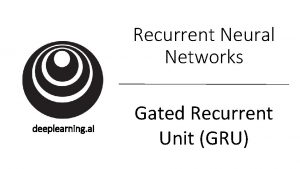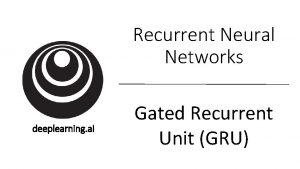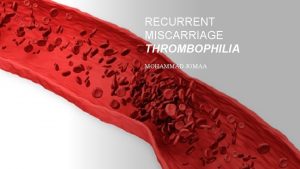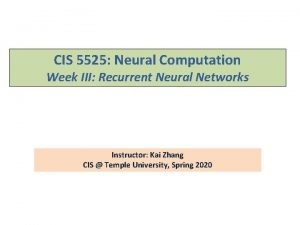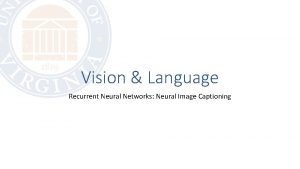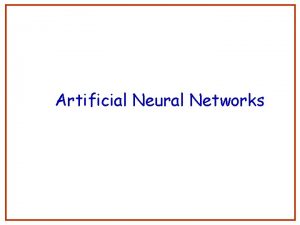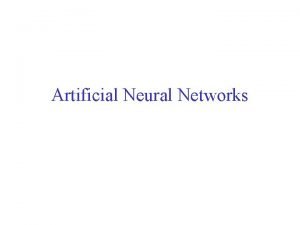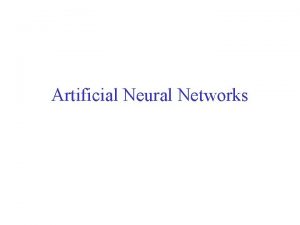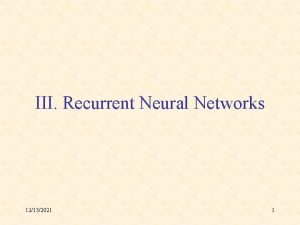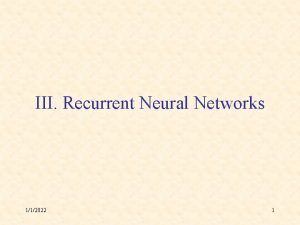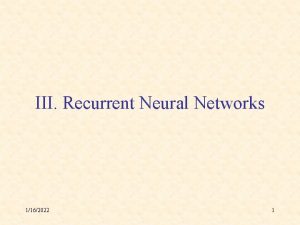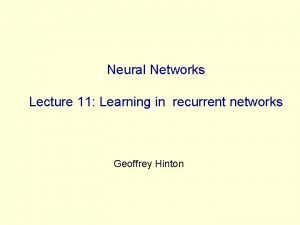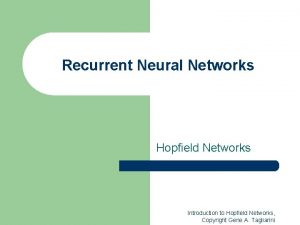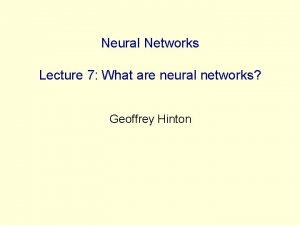III Recurrent Neural Networks 1102022 1 A The






















































































- Slides: 86

III. Recurrent Neural Networks 1/10/2022 1

A. The Hopfield Network 1/10/2022 2

Typical Artificial Neuron connection weights inputs output threshold 1/10/2022 3

Typical Artificial Neuron linear combination activation function net input (local field) 1/10/2022 4

Equations Net input: New neural state: 1/10/2022 5

Hopfield Network • • • Symmetric weights: wij = wji No self-action: wii = 0 Zero threshold: q = 0 Bipolar states: si {– 1, +1} Discontinuous bipolar activation function: 1/10/2022 6

What to do about h = 0? • There are several options: § § s(0) = +1 s(0) = – 1 or +1 with equal probability hi = 0 no state change (si = si) • Not much difference, but be consistent • Last option is slightly preferable, since symmetric 1/10/2022 7

Positive Coupling • Positive sense (sign) • Large strength 1/10/2022 8

Negative Coupling • Negative sense (sign) • Large strength 1/10/2022 9

Weak Coupling • Either sense (sign) • Little strength 1/10/2022 10

State = – 1 & Local Field < 0 h<0 1/10/2022 11

State = – 1 & Local Field > 0 h>0 1/10/2022 12

State Reverses h>0 1/10/2022 13

State = +1 & Local Field > 0 h>0 1/10/2022 14

State = +1 & Local Field < 0 h<0 1/10/2022 15

State Reverses h<0 1/10/2022 16

Net. Logo Demonstration of Hopfield State Updating Run Hopfield-update. nlogo 1/10/2022 17

Hopfield Net as Soft Constraint Satisfaction System • States of neurons as yes/no decisions • Weights represent soft constraints between decisions – hard constraints must be respected – soft constraints have degrees of importance • Decisions change to better respect constraints • Is there an optimal set of decisions that best respects all constraints? 1/10/2022 18

Demonstration of Hopfield Net Dynamics I Run Hopfield-dynamics. nlogo 1/10/2022 19

Convergence • Does such a system converge to a stable state? • Under what conditions does it converge? • There is a sense in which each step relaxes the “tension” in the system • But could a relaxation of one neuron lead to greater tension in other places? 1/10/2022 20

Quantifying “Tension” • If wij > 0, then si and sj want to have the same sign (si sj = +1) • If wij < 0, then si and sj want to have opposite signs (si sj = – 1) • If wij = 0, their signs are independent • Strength of interaction varies with |wij| • Define disharmony (“tension”) Dij between neurons i and j: Dij = – si wij sj Dij < 0 they are happy Dij > 0 they are unhappy 1/10/2022 21

Total Energy of System The “energy” of the system is the total “tension” (disharmony) in it: 1/10/2022 22

Review of Some Vector Notation (column vectors) (inner product) (outer product) (quadratic form) 1/10/2022 23

Another View of Energy The energy measures the number of neurons whose states are in disharmony with their local fields (i. e. of opposite sign): 1/10/2022 24

Do State Changes Decrease Energy? • Suppose that neuron k changes state • Change of energy: 1/10/2022 25

Energy Does Not Increase • In each step in which a neuron is considered for update: E{s(t + 1)} – E{s(t)} 0 • Energy cannot increase • Energy decreases if any neuron changes • Must it stop? 1/10/2022 26

Proof of Convergence in Finite Time • There is a minimum possible energy: – The number of possible states s {– 1, +1}n is finite – Hence Emin = min {E(s) | s { 1}n} exists • Must show it is reached in a finite number of steps 1/10/2022 27

Steps are of a Certain Minimum Size 1/10/2022 28

Conclusion • If we do asynchronous updating, the Hopfield net must reach a stable, minimum energy state in a finite number of updates • This does not imply that it is a global minimum 1/10/2022 29

Lyapunov Functions • A way of showing the convergence of discreteor continuous-time dynamical systems • For discrete-time system: – need a Lyapunov function E (“energy” of the state) – E is bounded below (E{s} > Emin) – DE < (DE)max 0 (energy decreases a certain minimum amount each step) – then the system will converge in finite time • Problem: finding a suitable Lyapunov function 1/10/2022 30

Example Limit Cycle with Synchronous Updating w>0 1/10/2022 w>0 31

The Hopfield Energy Function is Even • A function f is odd if f (–x) = – f (x), for all x • A function f is even if f (–x) = f (x), for all x • Observe: 1/10/2022 32

Conceptual Picture of Descent on Energy Surface 1/10/2022 (fig. from Solé & Goodwin) 33

Energy Surface 1/10/2022 (fig. from Haykin Neur. Netw. ) 34

Energy Surface + Flow Lines 1/10/2022 (fig. from Haykin Neur. Netw. ) 35

Flow Lines Basins of Attraction 1/10/2022 (fig. from Haykin Neur. Netw. ) 36

Bipolar State Space 1/10/2022 37

Basins in Bipolar State Space energy decreasing paths 1/10/2022 38

Demonstration of Hopfield Net Dynamics II Run initialized Hopfield. nlogo 1/10/2022 39

Storing Memories as Attractors 1/10/2022 (fig. from Solé & Goodwin) 40

Example of Pattern Restoration 1/10/2022 (fig. from Arbib 1995) 41

Example of Pattern Restoration 1/10/2022 (fig. from Arbib 1995) 42

Example of Pattern Restoration 1/10/2022 (fig. from Arbib 1995) 43

Example of Pattern Restoration 1/10/2022 (fig. from Arbib 1995) 44

Example of Pattern Restoration 1/10/2022 (fig. from Arbib 1995) 45

Example of Pattern Completion 1/10/2022 (fig. from Arbib 1995) 46

Example of Pattern Completion 1/10/2022 (fig. from Arbib 1995) 47

Example of Pattern Completion 1/10/2022 (fig. from Arbib 1995) 48

Example of Pattern Completion 1/10/2022 (fig. from Arbib 1995) 49

Example of Pattern Completion 1/10/2022 (fig. from Arbib 1995) 50

Example of Association 1/10/2022 (fig. from Arbib 1995) 51

Example of Association 1/10/2022 (fig. from Arbib 1995) 52

Example of Association 1/10/2022 (fig. from Arbib 1995) 53

Example of Association 1/10/2022 (fig. from Arbib 1995) 54

Example of Association 1/10/2022 (fig. from Arbib 1995) 55

Applications of Hopfield Memory • • 1/10/2022 Pattern restoration Pattern completion Pattern generalization Pattern association 56

Hopfield Net for Optimization and for Associative Memory • For optimization: – we know the weights (couplings) – we want to know the minima (solutions) • For associative memory: – we know the minima (retrieval states) – we want to know the weights 1/10/2022 57

Hebb’s Rule “When an axon of cell A is near enough to excite a cell B and repeatedly or persistently takes part in firing it, some growth or metabolic change takes place in one or both cells such that A’s efficiency, as one of the cells firing B, is increased. ” —Donald Hebb (The Organization of Behavior, 1949, p. 62) 1/10/2022 58

Example of Hebbian Learning: Pattern Imprinted 1/10/2022 59

Example of Hebbian Learning: Partial Pattern Reconstruction 1/10/2022 60

Mathematical Model of Hebbian Learning for One Pattern For simplicity, we will include self-coupling: 1/10/2022 61

A Single Imprinted Pattern is a Stable State • Suppose W = xx. T • Then h = Wx = xx. Tx = nx since • Hence, if initial state is s = x, then new state is s = sgn (n x) = x • May be other stable states (e. g. , –x) 1/10/2022 62

Questions • How big is the basin of attraction of the imprinted pattern? • How many patterns can be imprinted? • Are there unneeded spurious stable states? • These issues will be addressed in the context of multiple imprinted patterns 1/10/2022 63

Imprinting Multiple Patterns • Let x 1, x 2, …, xp be patterns to be imprinted • Define the sum-of-outer-products matrix: 1/10/2022 64

Definition of Covariance Consider samples (x 1, y 1), (x 2, y 2), …, (x. N, y. N) 1/10/2022 65

Weights & the Covariance Matrix Sample pattern vectors: x 1, x 2, …, xp Covariance of ith and jth components: 1/10/2022 66

Characteristics of Hopfield Memory • Distributed (“holographic”) – every pattern is stored in every location (weight) • Robust – correct retrieval in spite of noise or error in patterns – correct operation in spite of considerable weight damage or noise 1/10/2022 67

Demonstration of Hopfield Net Run Malasri Hopfield Demo 1/10/2022 68

Stability of Imprinted Memories • Suppose the state is one of the imprinted patterns xm • Then: 1/10/2022 69

Interpretation of Inner Products • xk xm = n if they are identical – highly correlated • xk xm = –n if they are complementary – highly correlated (reversed) • xk xm = 0 if they are orthogonal – largely uncorrelated • xk xm measures the crosstalk between patterns k and m 1/10/2022 70

Cosines and Inner products u v 1/10/2022 71

Conditions for Stability 1/10/2022 72

Sufficient Conditions for Instability (Case 1) 1/10/2022 73

Sufficient Conditions for Instability (Case 2) 1/10/2022 74

Sufficient Conditions for Stability The crosstalk with the sought pattern must be sufficiently small 1/10/2022 75

Capacity of Hopfield Memory • Depends on the patterns imprinted • If orthogonal, pmax = n – but every state is stable trivial basins • So pmax < n • Let load parameter a = p / n 1/10/2022 equations 76

Single Bit Stability Analysis • For simplicity, suppose xk are random • Then xk xm are sums of n random 1 § § binomial distribution ≈ Gaussian in range –n, …, +n with mean m = 0 and variance s 2 = n • Probability sum > t: [See “Review of Gaussian (Normal) Distributions” on course website] 1/10/2022 77

Approximation of Probability 1/10/2022 78

Probability of Bit Instability 1/10/2022(fig. from Hertz & al. Intr. Theory Neur. Comp. ) 79

Tabulated Probability of Single-Bit Instability a Perror 1/10/2022 0. 1% 0. 105 0. 36% 0. 138 1% 0. 185 5% 0. 37 10% 0. 61 (table from Hertz & al. Intr. Theory Neur. Comp. ) 80

Spurious Attractors • Mixture states: – – – sums or differences of odd numbers of retrieval states number increases combinatorially with p shallower, smaller basins of mixtures swamp basins of retrieval states overload useful as combinatorial generalizations? self-coupling generates spurious attractors • Spin-glass states: – not correlated with any finite number of imprinted patterns – occur beyond overload because weights effectively random 1/10/2022 81

Basins of Mixture States 1/10/2022 82

Fraction of Unstable Imprints (n = 100) 1/10/2022 (fig from Bar-Yam) 83

Number of Stable Imprints (n = 100) 1/10/2022 (fig from Bar-Yam) 84

Number of Imprints with Basins of Indicated Size (n = 100) 1/10/2022 (fig from Bar-Yam) 85

Summary of Capacity Results • Absolute limit: pmax < acn = 0. 138 n • If a small number of errors in each pattern permitted: pmax n • If all or most patterns must be recalled perfectly: pmax n / log n • Recall: all this analysis is based on random patterns • Unrealistic, but sometimes can be arranged 1/10/2022 III B 86
 Pixel recurrent neural networks
Pixel recurrent neural networks Andrew ng lstm
Andrew ng lstm Lstm colah
Lstm colah Recurrent neural network based language model
Recurrent neural network based language model Extensions of recurrent neural network language model
Extensions of recurrent neural network language model Cs 231 n
Cs 231 n Visualizing and understanding recurrent networks
Visualizing and understanding recurrent networks Netinsights
Netinsights Neural networks for rf and microwave design
Neural networks for rf and microwave design Audio super resolution using neural networks
Audio super resolution using neural networks Neural networks and learning machines
Neural networks and learning machines Convolutional neural networks
Convolutional neural networks On the computational efficiency of training neural networks
On the computational efficiency of training neural networks Convolutional neural networks ppt
Convolutional neural networks ppt Deep neural networks and mixed integer linear optimization
Deep neural networks and mixed integer linear optimization Lmu cis
Lmu cis Visualizing and understanding convolutional networks
Visualizing and understanding convolutional networks 11-747 neural networks for nlp
11-747 neural networks for nlp Convolutional neural networks for visual recognition
Convolutional neural networks for visual recognition The wake-sleep algorithm for unsupervised neural networks
The wake-sleep algorithm for unsupervised neural networks Tlu in neural network
Tlu in neural network Neural networks and learning machines 3rd edition
Neural networks and learning machines 3rd edition Neuraltools neural networks
Neuraltools neural networks Few shot learning with graph neural networks
Few shot learning with graph neural networks Vc dimension of neural networks
Vc dimension of neural networks Neural networks simon haykin
Neural networks simon haykin Leon gatys
Leon gatys Bharath subramanyam
Bharath subramanyam Neural networks and fuzzy logic
Neural networks and fuzzy logic Matlab neural network toolbox pdf
Matlab neural network toolbox pdf Formation of neural networks ib psychology
Formation of neural networks ib psychology Predicting nba games using neural networks
Predicting nba games using neural networks Deep forest: towards an alternative to deep neural networks
Deep forest: towards an alternative to deep neural networks Sparse convolutional neural networks
Sparse convolutional neural networks Efficient processing of deep neural networks pdf
Efficient processing of deep neural networks pdf Alternatives to convolutional neural networks
Alternatives to convolutional neural networks Hamlet act iii scene ii
Hamlet act iii scene ii Virtual circuit and datagram networks in computer networks
Virtual circuit and datagram networks in computer networks Basestore iptv
Basestore iptv Simple recurrent network
Simple recurrent network Part 135 recurrent training
Part 135 recurrent training Vocal cord position
Vocal cord position Zeenat antibiotics
Zeenat antibiotics Curved lines in hair design
Curved lines in hair design Recurrent stroke causes
Recurrent stroke causes Vocal cord palsy
Vocal cord palsy Upper limb
Upper limb Posterior tibial artery
Posterior tibial artery Artery of heubner
Artery of heubner 4th aortic arch derivatives
4th aortic arch derivatives Thyrocricoidectomy
Thyrocricoidectomy Arytenoid cartilage
Arytenoid cartilage Recurrent yolo
Recurrent yolo A recurrent image in a literary work is the
A recurrent image in a literary work is the Recurrent connection
Recurrent connection A recurrent bert-based model for question generation
A recurrent bert-based model for question generation Recurrent stroke causes
Recurrent stroke causes Môn thể thao bắt đầu bằng chữ đua
Môn thể thao bắt đầu bằng chữ đua Khi nào hổ con có thể sống độc lập
Khi nào hổ con có thể sống độc lập điện thế nghỉ
điện thế nghỉ Nguyên nhân của sự mỏi cơ sinh 8
Nguyên nhân của sự mỏi cơ sinh 8 Trời xanh đây là của chúng ta thể thơ
Trời xanh đây là của chúng ta thể thơ Gấu đi như thế nào
Gấu đi như thế nào Thiếu nhi thế giới liên hoan
Thiếu nhi thế giới liên hoan Thế nào là số nguyên tố
Thế nào là số nguyên tố Vẽ hình chiếu vuông góc của vật thể sau
Vẽ hình chiếu vuông góc của vật thể sau Các châu lục và đại dương trên thế giới
Các châu lục và đại dương trên thế giới Một số thể thơ truyền thống
Một số thể thơ truyền thống Thế nào là hệ số cao nhất
Thế nào là hệ số cao nhất Hát kết hợp bộ gõ cơ thể
Hát kết hợp bộ gõ cơ thể Hệ hô hấp
Hệ hô hấp Tư thế ngồi viết
Tư thế ngồi viết đặc điểm cơ thể của người tối cổ
đặc điểm cơ thể của người tối cổ Mật thư anh em như thể tay chân
Mật thư anh em như thể tay chân Tư thế worm breton
Tư thế worm breton ưu thế lai là gì
ưu thế lai là gì Thẻ vin
Thẻ vin Cái miệng nó xinh thế
Cái miệng nó xinh thế Thể thơ truyền thống
Thể thơ truyền thống Các châu lục và đại dương trên thế giới
Các châu lục và đại dương trên thế giới Từ ngữ thể hiện lòng nhân hậu
Từ ngữ thể hiện lòng nhân hậu Ng-html
Ng-html Tư thế ngồi viết
Tư thế ngồi viết Diễn thế sinh thái là
Diễn thế sinh thái là Thế nào là giọng cùng tên
Thế nào là giọng cùng tên Làm thế nào để 102-1=99
Làm thế nào để 102-1=99 Alleluia hat len nguoi oi
Alleluia hat len nguoi oi


